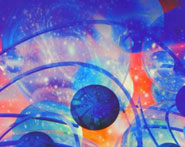


 الفيزياء الكلاسيكية
الفيزياء الكلاسيكية
 الكهربائية والمغناطيسية
الكهربائية والمغناطيسية
 علم البصريات
علم البصريات
 الفيزياء الحديثة
الفيزياء الحديثة
 النظرية النسبية
النظرية النسبية
 الفيزياء النووية
الفيزياء النووية
 فيزياء الحالة الصلبة
فيزياء الحالة الصلبة
 الليزر
الليزر
 علم الفلك
علم الفلك
 المجموعة الشمسية
المجموعة الشمسية
 الطاقة البديلة
الطاقة البديلة
 الفيزياء والعلوم الأخرى
الفيزياء والعلوم الأخرى
 مواضيع عامة في الفيزياء
مواضيع عامة في الفيزياء|
Read More
Date: 1-11-2016
Date: 29-10-2016
Date: 2-10-2016
|
Space Curvature
The general theory of relativity (GTR) has been checked and verified at local distance scales. We know that the GTR may not explain the rotation curves of galaxies without the introduction of “dark matter.” We do not expect the GTR to work for extremely small distances, for extremely short time intervals, or for cosmological distances that is, whether the GTR correctly explains the universe on a global scale. The GTR, for example, allows for the overall curvature of space but does not predict its global value. In better words, the GTR does not fully predict the geometry of space, neither determining the global shape nor the connectedness of space.
Suppose you were given the task of measuring the overall curvature of space. One way might be to count the number of stars at each radial distance, say, and plot the number found versus distance. How does this method determine the curvature of space? Does this technique work for both continuous and discrete spaces?
Answer
The proposed method for determining the curvature of space will work for both continuous and discrete spaces. If we assume a uniform density of stars, or galaxies if we choose to count galaxies, the number N of this particular kind of source within a sphere of radius R in a Euclidean space (zero curvature space) is given by N = ρ 4πR3/3, where ρ is the uniform density. When N is plotted against the distance, N will fall short, match, or exceed the cubic curve for the three types of spaces: positively curved, flat, or negatively curved, respectively.
On a “small” scale, when the total number of sources is less than a few hundred, there can be a relatively large uncertainty in the general behavior of the plotted curve. But as more and more sources are counted at farther distances, the asymptotic behavior should become apparent. However, adjustments must be made for the finite velocity of light and for possible evolutionary changes in the sources. Distant sources are sampled at an earlier time, possibly at a closer distance.
If the universe is actually representative of a discrete space, one can show that by counting many sources one can determine the curvature in the limit as the number of sources becomes large. Think of a lattice of points as one simple example, such as a regular lattice of atoms in a solid. By counting the nearest neighbors only, then the next nearest neighbors, and so on, one eventually approaches asymptotically to a plotted line from which the curvature can be determined.
Of course, in a discrete space, one must be careful not to count over and over the images of the same source. For example, imagine space divided into identical cubes next to each other and filling all space. Standing inside one cube, we can look to our right to see ourselves inside the first cube on our right looking away to the next cube, and so on. Each successive image will be dimmer and will be earlier in time because the light does not travel infinitely fast. If our real space in the universe is discrete, the cube size would be enormous, certainly way beyond the size of our Local Group of galaxies; otherwise we would have detected this discreteness already by having seen multiple images of our own Galaxy.
If space in the universe is curved, then cubes will not fill the space. Mathematicians point out that one of the dodecahedral spaces would be the simplest space-filling for a negatively curved discrete space, the most likely type of space curvature for the universe. However, the curvature of the universe is not known unambiguously yet, although a flat space with no curvature will nicely fit the present data in the standard model of an inflationary big bang universe.



|
|
|
|
لخفض ضغط الدم.. دراسة تحدد "تمارين مهمة"
|
|
|
|
|
|
|
طال انتظارها.. ميزة جديدة من "واتساب" تعزز الخصوصية
|
|
|
|
|
|
|
مشاتل الكفيل تزيّن مجمّع أبي الفضل العبّاس (عليه السلام) بالورد استعدادًا لحفل التخرج المركزي
|
|
|